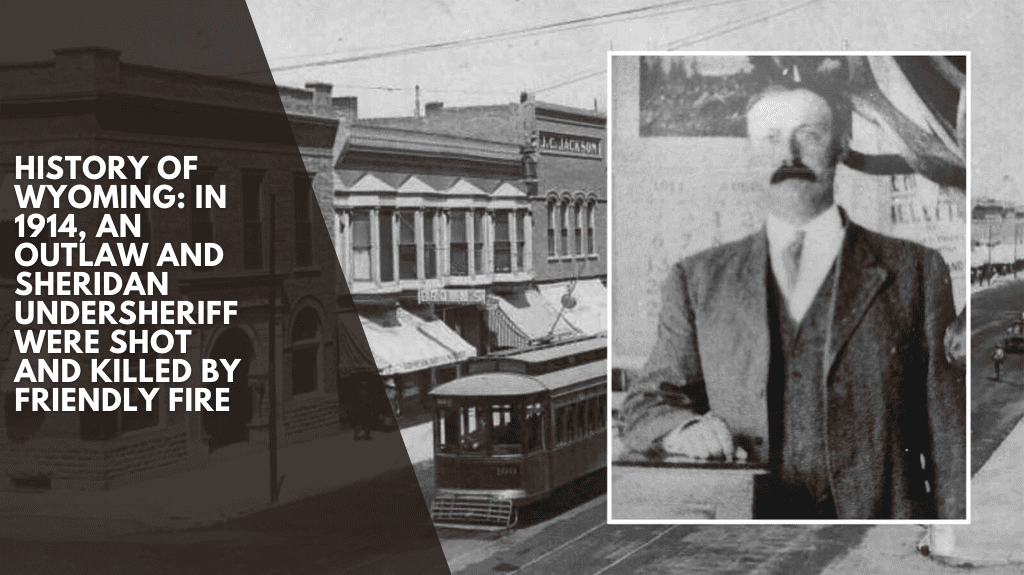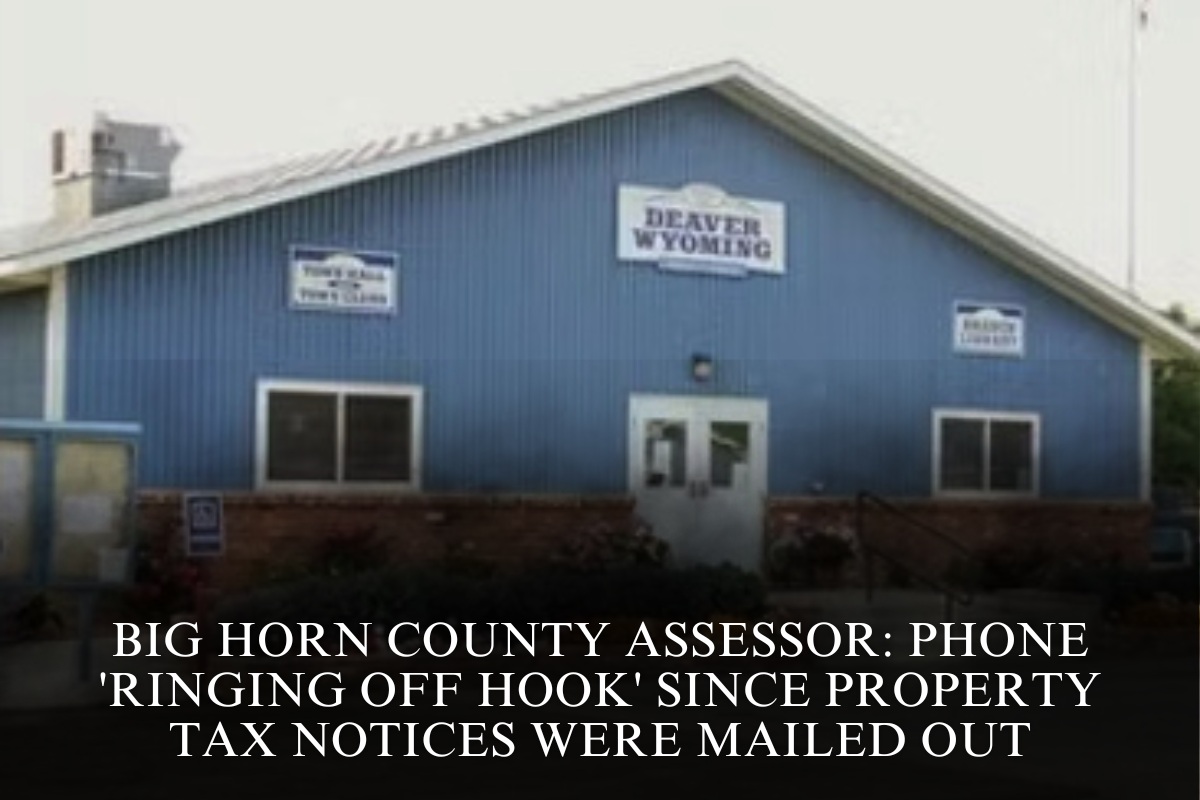If not for a governor’s pardon, Earl Foree would have spent a week in Wyoming’s state prison in June 1914 after riding into the Sheridan area on a stolen horse.
He cantered on a valuable blazed-faced saddle horse owned by Big Horn County Deputy Sheriff Frank Rue of Basin.
After stealing the horse, Foree told a man at a ranch in the Big Horn Mountains where he had spent the night that he was on his way to Sheridan to kill people he blamed for putting him in prison ten years ago.
Following the assassination of Austria’s archduke, World War I was about to break out across the globe. Henry Ford announced earlier this year that he would pay his employees $5 per day for eight hours of work, transforming American manufacturing.
The first commercial airplane flight occurred a few months earlier, on January 1, when a passenger was ferried from St. Petersburg, Fla. to Tampa.
But Foree, 35, was still living the wild-west outlaw lifestyle. On Saturday, June 13, 1914, he was involved in a gunfight that resulted in his death, as well as the death of well-known Sheridan County Undersheriff William Veach and the wounding of Rue.
“Undersheriff Veach Is Shot Dead,” read a headline in The Sheridan Enterprise on June 14. “Desperado Kills Officer, Wounds Deputy and Is Himself Shot.”
Current Sheridan County Sheriff Levi Dominguez stated that department officers see news articles about Veach’s death and the death of Undersheriff William McPherren seven years later on a daily basis.
“Both of those stories, and all of the news articles and clippings are in our hallway that leads them to our patrol writing room,” said the commander. “It’s a solemn reminder of what this job entails and the sacrifice that is made within our profession.”
The origins of the Veach headlines can be traced back to a trial in late December 1903, when Foree was described in Cheyenne’s Wyoming Tribune on December 29, 1903, as a “well-known ranchman from Slack.”
According to the newspaper, he was tried for burning down a neighbor’s barn.
Known Hoof Print
The Sheridan Post reported that the structure owned by E.C. Woodley of Pass Creek was torched on Sept. 27, 1902, and investigators had found hoofprints of a horse having a peculiar mark and known to belong to Foree.
Foree was also overheard at a train station telling his brother, who was charged with cattle theft, that he had “fixed Woodley.”
“Much other evidence was of the same nature was produced, consisting primarily of voluntary statements and admissions made in conversations with neighbors, sufficient to make a very strong case against him,” according to the press.
Foree was found guilty of arson and sentenced to fifteen years in prison.
Two years later, his family hired attorneys to petition Wyoming Gov. B.B. Brooks to release him. Foree was released in the fall of 1907 after demonstrating good behavior.
A short time later, in November 1907, Adam Eckhart, a state prison inmate serving a life sentence, acquired a pistol and 48 sticks of dynamite. He shot and killed a prison guard before attempting to escape by shooting dynamite through a prison door.
The dynamite did not explode, so Eckhart turned the pistol on himself.
However, questions were raised about how he obtained the pistol and dynamite. Foree was named as the suspect. When authorities searched for him, they discovered he had already crossed the state line.
Authorities apprehended him in a jail cell in Grand Junction, Colorado, and charged him with horse theft.
When acting Wyoming Gov. W.R. Schnitger granted Carbon County officials “a requisition on the governor of Colorado for the person of Earl Foree,” a Grand Junction prosecutor refused to release him.
Carbon Sheriff E.M. Horton intended to bring Foree back to face murder charges, according to The Carbon County Journal on February 9, 1908.
Pleading Guilty
Instead, Foree pleaded guilty to the Colorado horse theft charge, avoiding trial and a possible hanging in Rawlins.
In the spring of 1914, Foree was released from a Colorado prison and immediately returned to his old ways.
He embarked on a revenge mission, returning to Wyoming and making his way up to the Basin area.
While Big Horn Deputy Rue was in Billings, Montana, transporting an inmate, Foree stole a horse from his corral.
Rue later described Foree in a newspaper as being about 6-foot-1 and 165-170 pounds, “with dark hair, buttermilk blue eyes that were glassy and gave him a’maniacal expression.”
On June 14, 1914, The Sheridan Enterprise reported that after stealing the horse, Foree stopped at an E.L. Dana ranch in the Big Horn Mountains.
Dana was one of the men Foree wanted to kill, blaming him for funding the prosecution of his arson case in 1903.
Dana did not live there, but Foree informed Dana’s tenant rancher, Mr. Taylor, that he had returned to the Big Horn country to exact revenge on those responsible for his arson conviction.
“He said that a preacher had told him that it was Mr. Dana’s money that had convicted him, and he was going ‘to get’ Mr. Dana first,” according to the Enterprise!
Taylor acted to notify all of the men named by Foree that he was on his way to Sheridan.
Rue was also contacted about his stolen horse while in Billings, so he decided to travel to Parkman to try to intercept Foree.
When he arrived, he found that Foree had already left for Sheridan. He contacted the Sheridan County Sheriff’s Office, which searched for the horse and Foree on Friday evening but found no results.
pers.com)
Finding Foree
Saturday, the search effort continued with Veach and Rue and other officers combing the city for their suspect.
Foree was spotted in a real estate office, and an officer went to inform Veach and Rue of his whereabouts. Rue and another officer entered the real estate office, but Rue failed to recognize Foree, who slipped past them and out the door.
After realizing who he was, the officers decided to pursue him to see if he could lead them to the horse.
Instead, they noticed him entering a store.
As Veach approached the door to check on the outlaw, Foree rushed out and confronted him.
“He said he had work in town and wanted to know if the officers were for or against him,” the Sheridan Enterprise reported on June 14. Veach motioned for Rue to join them.
“Aren’t you the man who rode a sorrel horse over the mountains, down the Littlehorn, through Ranchester, down to Parkman and then into Sheridan?” Rue asked.
Foree denied this.
Shootout
According to the newspaper, Rue then confronted Foree, telling him, “You can consider yourself under arrest.”
Rue told the newspaper that Foree jumped back, pulled his gun, and fired.
Both Veach and Rue returned fire.
On June 14, 1914, the Sheridan Enterprise reported that the undersheriff, despite having a bullet through his heart and another in his back, stood up and fired one shot at the ex-convict. “Some say this was the bullet that grazed Foree’s skull and others state that it was Veach’s bullet that hit Foree in the abdomen.”
Rue told the Big Horn County Rustler newspaper on June 19, 1914, that the three of them were in a clinch and that after Foree was shot, Rue kept his grip on him and pulled his gun away from him.
“(Rue) says he believes Veach was killed by the last shot fired by Foree,” the Rustler reported.
Eyewitnesses stated that Veach was shot the first time Foree fired. The Sheridan Enterprise reported that the owner of a grocery store on Broadway Street in Sheridan held Veach’s head on his lap as he died.
A doctor treated Rue’s leg at the scene of the shooting, and a large crowd gathered to discuss lynching Foree, who had his leg broken.
Outlaw’s Wounds
Foree was taken to the jail and examined by doctors, who found three wounds — one in his abdominal cavity, a bullet in his right leg between the hip and the knee, and a bullet graze wound on his skull.
Rue’s injury turned out to be a painful muscle wound.
An examination of Foree’s.45-caliber revolver revealed that he had fired four times, Rue’s.38-caliber revolver had five chambers that were all empty, and Veach had shot his weapon once.
An initial coroner’s inquest determined that Veach died of a bullet to the heart fired by Foree.
The coroner questioned Foree as he lay on a cot, and he refused to answer.
“Cut it out, cut it out,” the coroner insisted, according to a Sheridan Enterprise reporter.
Dana, the ranchman on Foree’s kill list, told the newspaper that he was staying at the Sheridan Inn on Saturday morning when he saw Foree enter the dining room corridor and look in through the door.
“I looked at him and caught his attention. When he saw me looking at him, he quickly backed away and vanished,” Dana said. “I hardly knew what to do then, as I had left my gun upstairs in my room and was unarmed.”
He told the newspaper that he felt he had a “narrow escape” from a gunfight with him.
Meanwhile, on June 16, 1914, “scores of relatives and friends and members of the fraternal orders” to which Veach belonged attended his funeral at his home, according to The Sheridan Post.
Veach’s immediate family took his body to Hillsboro, Oregon, for burial.
Veach’s Autopsy
However, weeks later, Sheridan officials requested an autopsy to determine the lawman’s cause of death. The doctors traveled to Oregon to perform the procedure.
The Sheridan Enterprise reported on July 13, 1914, that during the autopsy, doctors extracted a.38-caliber bullet as well as a.45-caliber bullet. The.38-caliber bullet “penetrated” Veach’s “vital organs in nine different places.”
The.45-caliber weapon used by Foree entered Veach’s left breast, passing close to the heart but not close enough to cause immediate death, they determined.
Veach was killed by friendly fire.
Rue, who had just returned to Sheridan to pick up his stolen horse, was informed of the autopsy by a Sheridan County attorney.
“Rue broke down after hearing the news and has been in a serious mental state ever since. Despite the fact that he is not at fault, he is devastated by the entire situation,” according to the newspaper. “The Veach family knows that the shooting was accidental and puts no blame on Deputy Rue.”
Foree died from his wounds on July 12. He had been told before his death that his bullet may not have been the one that killed Veach.
“He said that Veach approached him and acted like a gentleman and asserted that he would have quietly submitted to arrest if Deputy Rue hadn’t come upon the scene,” the Sheridan Enterprise reported on July 13, 1914. “He expressed sorrow at the death of Veach.”
Foree’s body was transported to Miles, Montana, for burial.
Rue continued his law enforcement career for a few years. He later moved to Bridger, Montana, and died on April 20, 1938, at the age of 69.
Important Memories
Dominguez compared the deaths of Veach and Undersheriff McPherren, who was shot in 1921 during a raid on a bootlegger, to the tragic killing of Sheridan Police Officer Sgt. Nevada Krinkee on Feb. 13, 2024.
Krinkee’s death generated an outpouring support that stretched into the state and nation and will “certainly be remembered 100 years from now and even longer,” for his impact on the community, he said.
In the same way, Dominguez said Undersheriff Veach and Undersheriff McPherren are remembered more than 100 years later.
“It’s important for their families and everybody in the community to know the sacrifice that those three law enforcement officers in our county made,” he said.
Dominguez said his predecessor as sheriff had both Veach and McPherren’s names etched into the National Law Enforcement Memorial in Washington, D.C.












